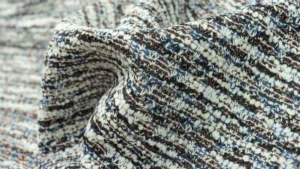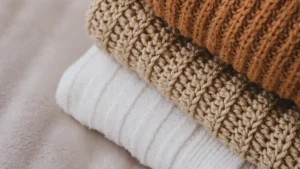
When you compare cashmere and wool, you find that wool stands out for water resistance and easier care. If you want a fabric that handles wet weather or daily use, wool keeps its shape and resists damage from moisture. Cashmere feels softer and gives a luxury touch, but it needs gentle care and costs more to maintain. You must avoid wringing or twisting cashmere because it stretches or shrinks easily. Can cashmere get wet? Yes, but you must dry it flat and store it carefully to keep it looking new. Both are luxurious fabrics, but wool clothing lasts longer and resists stains better.
Key Takeaways
Wool keeps out water better than cashmere. Wool keeps you warm even if it gets wet. This makes wool good for rainy days and being outside. Cashmere feels softer and warmer than wool. But you must wash cashmere by hand and dry it carefully. This stops it from stretching or getting ruined. Wool is stronger and lasts longer than cashmere. You can often wash wool in a machine on gentle cycles. Cashmere needs more careful washing. For daily use, pick wool because it is tough and easy to clean. Pick cashmere when you want something soft or for special events. Always dry both fabrics flat. Do not twist or wring them. This helps them keep their shape and last longer.
Quick Comparison
Water Resistance
When you look at cashmere and wool, you see they handle water differently. Wool fibers have a special shape. They have layers that overlap and a waxy outside. This helps wool push water away but still lets air in. You can wear wool in light rain, and it keeps you warm and dry longer. Cashmere fibers are softer and thinner. They have shorter scales and do not grip each other well. Because of this, cashmere soaks up water faster and dries more slowly. If you wear cashmere in the rain, it can get heavy and lose its shape. Both fabrics can hold a lot of water, but wool does a better job keeping water out. Wool is a better choice for wet days or outdoor use.
Tip: The waxy layer on wool helps block water, but cashmere lets in more moisture because it is more porous.
Care and Maintenance
You need to be gentle with both cashmere and wool, but how you care for them is not the same. Experts say you should hand-wash both in cold water. For wool, use a soft soap and press out water gently. Never twist or wring wool. Lay it flat to dry and fix its shape while it is still damp. Cashmere needs even more care. Always use a detergent made for cashmere and do not soak it for more than ten minutes. Dry cashmere flat on a towel at room temperature. Keep it away from heat and sunlight.
Aspect | Wool Care Recommendations | Cashmere Care Recommendations |
|---|---|---|
Washing | Hand-wash or dry clean; gentle detergent; cold water; no wringing | Always hand-wash; cashmere-safe detergent; cold water; limit soak to 10 minutes |
Drying | Lay flat; reshape while damp; avoid sunlight | Lay flat on towel; reshape; air dry at room temperature; no heat |
Pilling Prevention | Use fabric comb or shaver; wash inside out | Use cashmere comb; avoid friction |
Storage | Fold in breathable bags; use cedar or lavender for moths | Fold in cotton bags; use moth repellents; keep cool and dry |
Special Notes | Wool is resilient but needs gentle care | Cashmere is delicate and needs stricter washing and drying routines |
You will pay about the same for professional cleaning for both, but you can usually wash them at home. Wool does not need dry cleaning very often. You can spot clean and steam it to keep it nice. Cashmere needs more careful washing and storage to stay looking good.
Difference Between Cashmere and Wool

Fiber Structure
When you look at the difference between cashmere and wool, you notice the fibers feel and behave differently. Cashmere fibers have a smooth surface with less pronounced scales. This smoothness gives cashmere its famous soft touch. You also find that cashmere has a hollow fiber structure. This helps it resist stains and dust, and it feels light when you wear it. Cashmere can absorb moisture up to about 30% of its weight, but it stays mostly antistatic and does not attract dirt easily.
Wool fibers, on the other hand, have a rougher surface. The scales on wool look like tiny roof tiles. These scales help wool push water away and make it more water-resistant. Wool also lets air move through, which helps with warmth and comfort. Because of its structure, wool can handle more washing and regular use. You can often refresh wool by airing it out, and you do not need to wash it as often as cashmere.
Note: Cashmere needs gentle hand washing and careful drying to keep its shape. Wool can handle delicate machine washing with special detergent.
Durability
You want your clothes to last, so durability matters. Wool stands out for its strength and flexibility. The fibers in wool stretch and return to their original shape. This means wool resists wear and tear better than cashmere. Wool also has a natural crimp, which protects it from damage and helps it keep its shape after many wears.
Cashmere feels softer and lighter, but it is more delicate. The fine fibers in cashmere can pill and break down faster, especially if you wear them often. You need to handle cashmere with care. Hand washing or dry cleaning works best for cashmere, and you should avoid rough surfaces that can cause pilling.
Wool garments last longer under regular use.
Cashmere needs gentle care and wears out faster if used every day.
Cashmere garments look and feel luxurious but have a shorter lifespan.
If you want warmth and durability for daily wear, wool is the better choice. Cashmere gives you a soft, luxury feel, but you need to treat it gently to keep it looking new.
Cashmere: Water Resistance and Care

Can Cashmere Get Wet
You may wonder, can cashmere get wet? The answer is yes, but you need to handle it with care. Cashmere offers excellent insulation and feels much warmer than wool, even though it stays lightweight and breathable. The fine fibers trap heat and help your body stay comfortable. Cashmere also wicks moisture away, so you do not feel damp when you wear it. This makes cashmere clothing cozy in many conditions.
However, when cashmere gets wet, it becomes delicate. The fibers lose some strength and can stretch or lose their shape if you do not treat them gently. Moisture itself does not harm cashmere, but rough handling does. If you wear cashmere in the rain or spill water on it, avoid wringing or twisting the fabric. Instead, gently blot away excess water with a towel. Always lay the garment flat to dry. Hanging wet cashmere can cause it to stretch out of shape.
Tip: If your cashmere gets wet outdoors, gently pull it straight to avoid wrinkles and dry it flat as soon as possible. This helps keep your cashmere looking new.
To protect your cashmere, brush off snow or moisture right away. Wearing a thin layer underneath can also reduce exposure to sweat and body oils, which helps prevent stains. Consistent gentle care keeps your cashmere garments soft and beautiful.
Washing Cashmere
Washing cashmere takes patience and the right steps. You should always hand wash cashmere at a low temperature, around 30°C. Use a gentle detergent, such as baby shampoo or one made for wool. Never use harsh chemicals or bleach, as these can damage the fibers.
Follow these steps for best results:
Fill a clean basin with lukewarm water and add a small amount of gentle detergent.
Place your cashmere garment in the water and gently swirl it. Do not rub, scrub, or wring the fabric.
Let it soak for up to ten minutes. Swish it gently to help remove dirt.
Rinse the garment in clean, cool water. You may need to rinse twice to remove all soap.
To remove excess water, lay the cashmere flat on a towel. Roll the towel and garment together, pressing gently to squeeze out moisture. Do not twist or wring.
Unroll and lay the cashmere flat on a dry towel in a shaded area. Shape it to its original form and let it air dry. Avoid direct sunlight, radiators, or tumble dryers.
Note: Always check the care label before washing. Some cashmere items, like woven scarves or coats, may need professional cleaning.
Improper washing can cause pilling, stretching, fading, shrinking, or loss of shape. Using the wrong detergent or washing in hot water can damage the fibers. Always use cold or lukewarm water and handle the garment gently. If you need to remove pills, use a specialty wool comb before washing.
Here is a quick table to help you remember the do’s and don’ts:
Do’s for Washing Cashmere | Don’ts for Washing Cashmere |
|---|---|
Use hot water or washing machines | |
Use gentle, wool-safe detergent | Use bleach or harsh chemicals |
Gently squeeze out excess water | Wring, twist, or rub the fabric |
Dry flat in the shade | Hang or tumble dry |
Follow care label instructions | Ignore special cleaning instructions |
Proper washing and drying help your cashmere last longer and keep its softness. Store your cashmere folded in a cool, dry place, away from direct light and heat. Use a cashmere-safe conditioner if needed to keep the fibers soft.
Reminder: Consistent gentle cleaning and careful drying keep your cashmere garments looking and feeling luxurious for years.
Wool: Water Resistance and Care
Wool and Moisture
You might wonder why wool keeps you dry even when the weather turns wet. Wool fibers have a unique structure. Each fiber has a surface covered by tiny scales and a natural waxy coating called lanolin. This lanolin acts like a shield, making wool water-repellent. When you wear wool, water droplets tend to bead up and roll off instead of soaking in right away. This feature helps you stay comfortable in damp conditions.
Lanolin is not just a random feature. Sheep produce lanolin to protect their fleece from rain and cold. When you wear wool, you benefit from this natural protection. Over time, repeated washing can reduce the lanolin content, which makes the fabric less water-resistant. Some wool clothing gets a special treatment called Durable Water Repellent (DWR) to restore or boost this effect.
Wool does not just repel water. It also manages moisture well. The fibers can absorb water vapor from your skin and release it into the air. This means you stay dry and warm, even if you sweat or get caught in light rain. Scientific studies show that wool absorbs less moisture than silk and keeps its strength better when wet. Wool fibers also resist bacteria and keep their shape after getting wet.
Here is a table that compares wool’s performance in wet conditions to other natural fibers:
Aspect Tested | Wool Performance Details | Comparison to Other Natural Fibers (e.g., Silk) |
|---|---|---|
Moisture Absorption | Wool is highly hygroscopic but absorbs less moisture than silk. Moisture absorption varies with water type; max ~7.01% in composites. | Silk loses up to 20% strength when wet; wool retains better moisture management. |
Mechanical Properties (Tensile) | Wool fiber composites show ultimate stress of 26–38 MPa depending on composition; higher wool content increases tensile strength. | Wool composites have good load-bearing capacity and ductile fracture behavior. |
Chemical Absorption | Wool composites absorb saline and acids (HCl, HNO3, H2SO4) to varying degrees; surface treatments affect absorption. | Wool fibers show resistance to bacteria and moderate chemical resistance. |
Durability & Resilience | Wool fibers have good resilience, retain shape well, and burn slowly with minimal residue. | Wool is more resilient and durable compared to some other natural fibers. |
If you want the best wool to wear in wet weather, merino wool stands out. Merino wool fibers are finer and softer than regular wool. They keep you warm, wick away sweat, and dry quickly. Many outdoor brands use merino wool for base layers, socks, and hats because it performs well in changing weather.
Tip: If you compare cashmere vs merino, you will find that merino wool is more practical for outdoor activities and wet climates. Cashmere feels softer but does not handle moisture as well.
Washing Wool
You need to follow the right steps to keep your wool clothing in top shape. Wool is strong, but it can shrink or lose its shape if you wash it the wrong way. Always check the care label before you start. Some wool garments, especially those made from merino wool, can go in the washing machine on a gentle cycle. Others need hand washing.
Here are the best practices for washing and drying wool:
Use cold or lukewarm water below 30°C (86°F). Hot water can cause wool to shrink and felt.
Choose a wool-friendly detergent. Look for pH-neutral, bleach-free, and enzyme-free formulas. These protect the fibers and colors.
Skip fabric softeners. If you want to soften wool, add a splash of white vinegar during the rinse cycle.
Hand wash gently or use the delicate cycle on your machine. Place wool items in a mesh laundry bag to reduce friction.
Never wring or twist wet wool. Gently press out water or roll the garment in a towel to absorb moisture.
Lay wool flat on a clean towel to dry. Shape it to its original form and keep it away from direct sunlight or heat.
Store wool folded in breathable cotton bags or acid-free boxes. Use cedar balls or lavender sachets to keep moths away and maintain durability.
Note: Let your wool garments rest for 24 hours after wearing. This helps the fibers recover and keeps your clothing looking new.
Scientific research shows that machine washing can damage wool over time. The strong, swirling motion in most machines causes the fibers to rub together. This leads to felting shrinkage, which makes the garment smaller and less soft. Hand washing or using a gentle, tapping motion in the wash helps wool keep its shape and strength. If you want your merino wool clothing to last, avoid harsh machine cycles.
Merino wool is a favorite for many because it resists odors, dries fast, and feels soft against your skin. You can wear merino wool for days without washing, which makes it perfect for travel and outdoor adventures. When you do wash it, follow the steps above to keep it in great condition.
If you want to choose the best wool to wear for daily life, merino wool offers comfort, durability, and easy care. It works well for base layers, sweaters, and even socks. You get warmth without bulk, and you do not have to worry about moisture or odor.
🧺 Quick Reminder: Proper washing and drying help wool keep its water resistance and durability. Take care of your wool clothing, and it will keep you warm and dry for years.
Choosing Between Cashmere and Wool
Everyday Use
When you pick clothes for every day, you want them to feel good and last long. You also want them to be easy to wash. Cashmere feels very soft and smooth on your skin. It is a good choice if your skin is sensitive or if you want something fancy. But cashmere is not very strong. You must wash it by hand or take it to the dry cleaner. If you wear cashmere a lot, it can get fuzzy or lose its shape.
Wool, like merino wool, is better for daily use. It does not wear out fast. It keeps its shape and is easier to care for. You can wash many wool clothes by hand or in the machine. Wool also pulls sweat away from your skin and stops bad smells. This makes it great for busy or active days.
Here is a quick chart to help you choose:
Factor | Cashmere | Wool (including Merino) |
|---|---|---|
Warmth | Warmer, lightweight, soft | Warm, durable, better for outerwear |
Very soft, ideal for sensitive skin | Can be itchy unless blended or merino | |
Durability | Delicate, prone to pilling | More durable, resists wear |
Care | Hand wash or dry clean | Easier care, some machine washable |
Cost | More expensive | More affordable |
Breathability | Good, but less moisture-wicking | Excellent, best wool to wear for active use |
Tip: If you need clothes that do not bother your skin, cashmere is less likely to make you itch than regular wool.
Wet Weather
If you live where it rains a lot, your choice is important. Wool is better for wet weather. Its fibers have a coating that keeps water out. Wool keeps you warm even when it is damp. It also dries faster than cashmere. Merino wool is great for outdoor fun because it moves sweat away and does not smell bad.
Cashmere is warm but needs special care when wet. If it gets soaked, you must be gentle. Never twist or hang it to dry. Lay it flat and fix its shape so it does not get ruined. Cashmere keeps you warmer than wool, but it is not as good for rainy days.
Wool is stronger and better for wet weather.
You can wear cashmere in light rain, but always dry it flat and handle it gently.
Longevity
You want your favorite clothes to last a long time. Wool clothes, especially merino, do not get fuzzy or stretch out easily. They keep their shape and look nice after many washes. Wool fibers are thick and stretchy, so they can handle lots of use.
Cashmere is softer and lighter, but it is not as tough. It can get fuzzy and wear out faster if you wear it every day. To keep cashmere looking nice, wash it gently, fold it, and keep it safe from moths. If you do these things, both cashmere and wool can last for years, but wool usually lasts longer.
Note: For best results, always fold your sweaters and keep them in bags that let air in. Use cedar or lavender to keep bugs away.
In summary:
Pick wool or merino wool for busy days, wet weather, and easy washing.
Choose cashmere for softness, luxury, and special times.
If you compare cashmere vs merino, merino wool is better for daily and outdoor use, but cashmere feels softer and warmer.
You have learned that wool keeps out water better and is easier to take care of. Wool works well for people who are active or spend time outside. Cashmere feels softer and warmer, but you must handle it gently. New technology, like special coatings, helps cashmere resist water more. Wool is also getting stronger because of new ways to spin the fibers.
Best For | Wool (Merino) | Cashmere |
|---|---|---|
Great for rainy days | Better now with new coatings | |
Care | Simple, not too delicate | Needs soft, careful washing |
Lifestyle Fit | Good for busy, outdoor life | Best for fancy, indoor times |
Pick wool if you want clothes that last and are easy to wash.
Choose cashmere if you like soft, fancy clothes.
Think about what you do each day and how much time you want to spend caring for your clothes before you choose.
FAQ
Can you machine wash wool or cashmere?
You can machine wash some wool items on a gentle cycle. Always check the label first. Cashmere should always be hand washed. Machine washing cashmere can cause shrinking or damage.
What should you do if your cashmere sweater gets wet?
Gently blot the water with a towel. Lay the sweater flat to dry. Never wring or hang it. Shape it while damp to keep it looking new.
Does wool keep you warm if it gets wet?
Yes, wool keeps you warm even when wet. The fibers trap heat and wick moisture away from your skin. This makes wool a great choice for rainy or snowy days.
How can you prevent pilling on cashmere and wool?
Wash garments inside out.
Use a fabric comb or shaver.
Avoid rubbing against rough surfaces.
Store folded, not hung.
Regular gentle care helps reduce pilling and keeps your clothes looking fresh.
Is cashmere or wool better for people with sensitive skin?
Cashmere feels softer and smoother than most wool. If you have sensitive skin, you may find cashmere more comfortable. Merino wool is also soft and less likely to itch.









